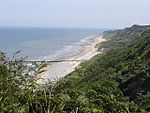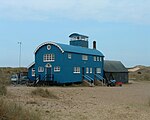North Norfolk Coast Site of Special Scientific Interest

The North Norfolk Coast Site of Special Scientific Interest (SSSI) is an area of European importance for wildlife in Norfolk, England. It comprises 7,700 ha (19,027 acres) of the county's north coast from just west of Holme-next-the-Sea to Kelling, and is additionally protected through Natura 2000, Special Protection Area (SPA) listings; it is also part of the Norfolk Coast Area of Outstanding Natural Beauty (AONB). The North Norfolk Coast is also designated as a wetland of international importance on the Ramsar list and most of it is a Biosphere Reserve. Habitats within the SSSI include reed beds, salt marshes, freshwater lagoons and sand or shingle beaches. The wetlands are important for wildlife, including some scarce breeding birds such as pied avocets, western marsh harriers, Eurasian bitterns and bearded reedlings. The location also attracts migrating birds including vagrant rarities. Ducks and geese winter along this coast in considerable numbers, and several nature reserves provide suitable conditions for water voles, natterjack toads and several scarce plants and invertebrates. The area is archaeologically significant, with artefacts dating back to the Upper Paleolithic. The mound of an Iron Age fort is visible at Holkham, and the site of a 23 ha (57 acres) Roman naval port with a fort built on the castrum pattern is just outside Brancaster. The site of the medieval "chapel" (probably a domestic dwelling) at Blakeney is no longer accessible. Remains of military use from both world wars include an armoured fighting vehicle gunnery range, a hospital and bombing ranges, as well as passive defences such as pillboxes, barbed wire and tank traps. The SSSI is economically important to the area because of the tourists it attracts for birdwatching and other outdoor activities, although sensitive wildlife sites are managed to avoid damage from the large numbers of visitors. Another threat is the encroachment of the sea on this soft coast. The Environment Agency considers that managed retreat is likely to be the long-term solution, and is working with the Norfolk Wildlife Trust to create new reserves inland to compensate for the loss of scarce habitats at the coast.
Excerpt from the Wikipedia article North Norfolk Coast Site of Special Scientific Interest (License: CC BY-SA 3.0, Authors, Images).North Norfolk Coast Site of Special Scientific Interest
Blakeney Road, North Norfolk Morston
Geographical coordinates (GPS) Address Nearby Places Show on map
Geographical coordinates (GPS)
| Latitude | Longitude |
|---|---|
| N 52.95 ° | E 1 ° |
Address
Blakeney Road
Blakeney Road
NR25 7BQ North Norfolk, Morston
England, United Kingdom
Open on Google Maps











